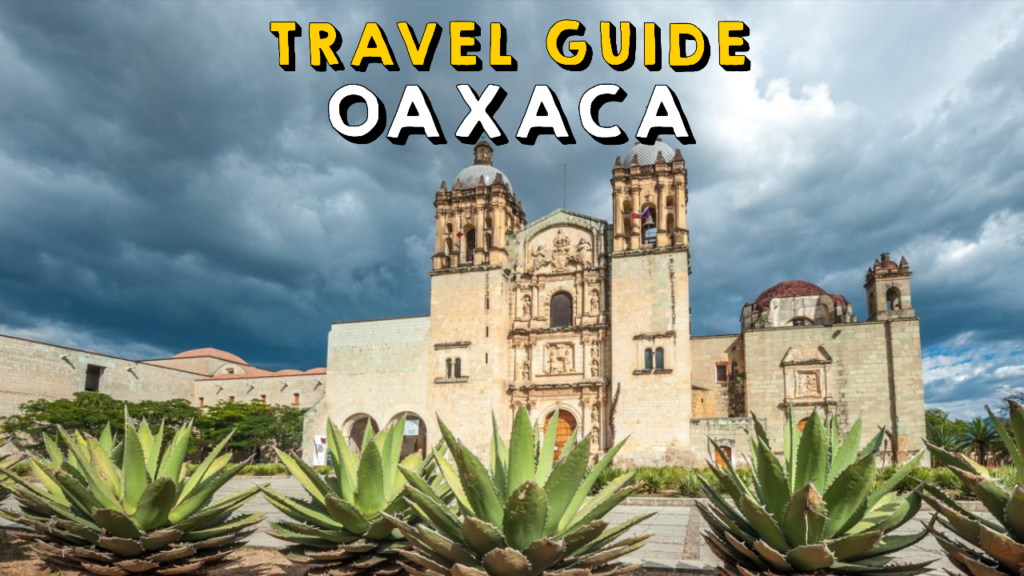Oaxaca is a World Heritage City in southern Mexico, and its distinct identity comes from indigenous cultures such as the Mixtec and Zapotec people. They established settlements nearby, and there are still significant minority groups throughout the country. Just minutes from Oaxaca is Monte Albán, a high Zapotec town perched on a ridge. After a few hours admiring the pyramids and cityscape, check out the Oaxaca Museum.
Oaxaca’s historic center is filled with colonial-era buildings built from the distinctive grey-green canter stone. The food is delicious, there are seven different mole sauces in Oaxaca, and nutritious but great grasshoppers are part of the local diet.

10 Top Things To Do In Oaxaca Mexico
- Monte Albán
- Museo de las Culturas
- Church of Santo Domingo de Guzmán
- Museo Rufino Tamayo
- Zócalo
- Árbol del Tule
- Plaza de la Danza
- Museo Textil
- Oaxaca Cathedral
- Jardín Etnobotánico
Monte Albán
This amazing archaeological site is located 10 kilometers southwest of Oaxaca, on a ridge at an altitude of 1,900 meters, 400 meters from the valley below.
The top of the ridge was leveled to create the acropolis in an almost impregnable position. The settlement here dates back to around 500 BC. and peaked in the middle of the 1st millennium AD. Then, for unknown reasons, in the 9th century, Mount Alban was abandoned and later, in the 13th century, it was used by the Mixtec culture as a burial place for their rulers. Many of the important sights include the northern platform, which may have been topped by a temple; Los Danzantes, with reliefs of Olmec movements in stone; South Platform (another impressive pyramid) and J Platform (probably an astronomical observatory).
Museo de las Culturas
The former monastery of Santo Domingo de Guzmán was founded in 1575 and operated from 1608 to 1857. Some buildings were used for military personnel during the War of Independence in the 1810s, but in the second half of the 19th century the entire monastery. became a monastery. military camp. Since 1972, the convent has become a first-class museum that presents a timeline of Oaxaca’s human history in 14 rooms.
You start with hunter-gatherers 10,000 years ago and travel through the Zapotecs, the abandonment of Mesoamerica’s great cities like Monte Albán, the arrival of the Spanish, the emergence of new nations in the 19th century, and the lives of modern-day aboriginal communities in Oaxaca. The galleries in each room are worth checking out, but if you only have time to browse, be sure to check out the gold jewelry, masks, and crystal vessels from Tomb 7 on Mount Alban.
Church of Santo Domingo de Guzmán

The monastery church, connected to the monastery museum, was completed in 1731 and restored in 1993. It has an extremely rich stucco rendering that rivals that of the Rosario Chapel in Puebla. At the arched entrance you can feel the tree of Jesse, which represents the ancestors of Christ.
The connected pattern fills all interior surfaces and is depicted in gold on the column recesses, around the box ceiling and around the many polychrome sculptures. The statistics of this monument are staggering: more than 60,000 sheets of 23.5 carat gold were used for decoration.
Museo Rufino Tamayo

Museo Rufino Tamayo in Oaxaca was founded by the famous artist of the same name and is housed in a magnificent 18th-century viceroy’s house.
The museum is dedicated exclusively to the pre-Hispanic art that Tamayo drew inspiration from and collected throughout Mexico. In a way, the museum could be said to have three periods: pre-Hispanic art, the colonial area, and the modern period, where Tamayo curates the exhibitions and sets its color palette. More than 700 objects are on display in five rooms, including stone figures and sculptures (check out the lively dogs), pottery and reliefs.
Zócalo

Located between the Cathedral and the Government Palace, the Zócalo is surrounded by Montezuma cypress trees and centered around an Art Nouveau cabana installed in 1901. The Marimba Orchestra of Oaxaca (Marimba del Estado de Oaxaca) occasionally gives musical performances in this charming place.
These are just some of the many events that take place in the square, such as the Grito de Dolores event on the evening of September 15.
That night, the mayor recounted a speech first given by the martyr of the War of Independence, Miguel Hidalgo. Each line was met with enthusiastic shouts of “Long live!” There is also a more esoteric event on December 23, La Noche de Rábanos (Night of the Radishes), where radishes are carved into weird and wonderful images that wilt after a few hours.
Árbol del Tule
Less than 10 kilometers to the east is the town of Santa María del Tule. In the center of the city there is a 40-meter tall Montezuma cypress.
Its age is unknown, but ranges from 1200 to 3000 years. Intertwined with Zapotec legend, the tree was planted at a spiritually significant site and is said to have been planted by the wind god Ehecatl, an Aztec priest.
The width of the trunk should also be taken into account. Not counting the buttresses, the last measured diameter was 9.39 meters, making the Árbol del Tule the fattest tree in the world.
Five hundred people could stand under its shadow!
Plaza de la Danza

Near the base of the Cerro del Fortín, a few blocks west of the Zócalo, is a series of majestic plazas that span the view of Monte Albán from the highest point of the former convent of the Convent of San José.
The entire square was paved with local Cantera volcanic stone in 1959 as a venue for art exhibitions, political rallies and musical performances. During the week of the Day of the Dead, around November 2nd, the square in front of La Soledad Church is covered with a huge tapestry of sand.
On the south side of the Plaza de la Danza, try the traditional Oaxaca sorbet (nieve de Oaxaca sorbet), made from red cactus pears (tun roja).
Museo Textil

The museum was established in 2006 and showcases the world of textiles, focusing on traditional Oaxacan weaving, dyeing, embroidery and beadwork.
The permanent exhibits, donated by private collectors and totaling 5,000 pieces, are all imaginatively combined with temporary exhibits that showcase all aspects of clothing and textiles, from contemporary fashion to ancient techniques from across Mexico, Guatemala and Ecuador. The building itself, which is located in the corner of a row of 18th-century mansions with a closed small courtyard, is also beautiful.
When you see these brightly colored quilts and garments up close, you understand the high level of craftsmanship achieved using the techniques handed down by the Zapotec people.
Oaxaca Cathedral

Construction of this cathedral began in 1535 and, like other historical monuments in Oaxaca, is built of green volcanic stone. Earthquakes required numerous reconstructions over the next 200 years, and the monument that stands today was unveiled in 1733.
The towers on both sides of the rounded pediment are more original and rebuilt after another earthquake in 1931. The interior is completely built in the 19th century neoclassical style, in the center of which is an altar with a bronze image of the Assumption of the Blessed Virgin Mary. Maria, made in 1931. Italy during the Porphyry regime.
Jardín Etnobotánico
In the 1990s, before painter and sculptor Francisco Toledo came up with the idea of creating a botanical garden, the former shooting range was in danger of being turned into a luxury hotel and parking lot.
Covering more than 2.3 hectares, there are hundreds of plant species, all indigenous: they come from dry and wet climates, temperate regions and cold mountains, offering a diversity of plants. The most intriguing is the section of the Guilá Naquitz cave near the Zapotec settlement of Mitra.
Corn and pumpkin seeds found in the cave are 7,000 years old and are the oldest evidence of agriculture in the Americas. You can also find the cactus Echinocactus Platyacanthus biznaga, which can be up to 1000 years old and weigh up to 5 tons.


